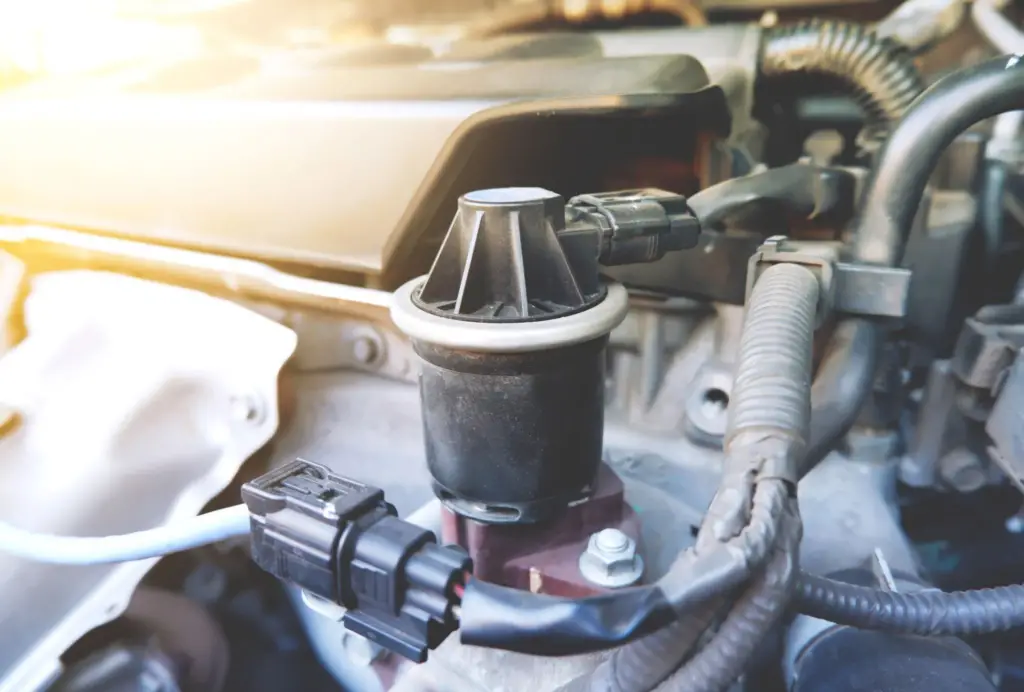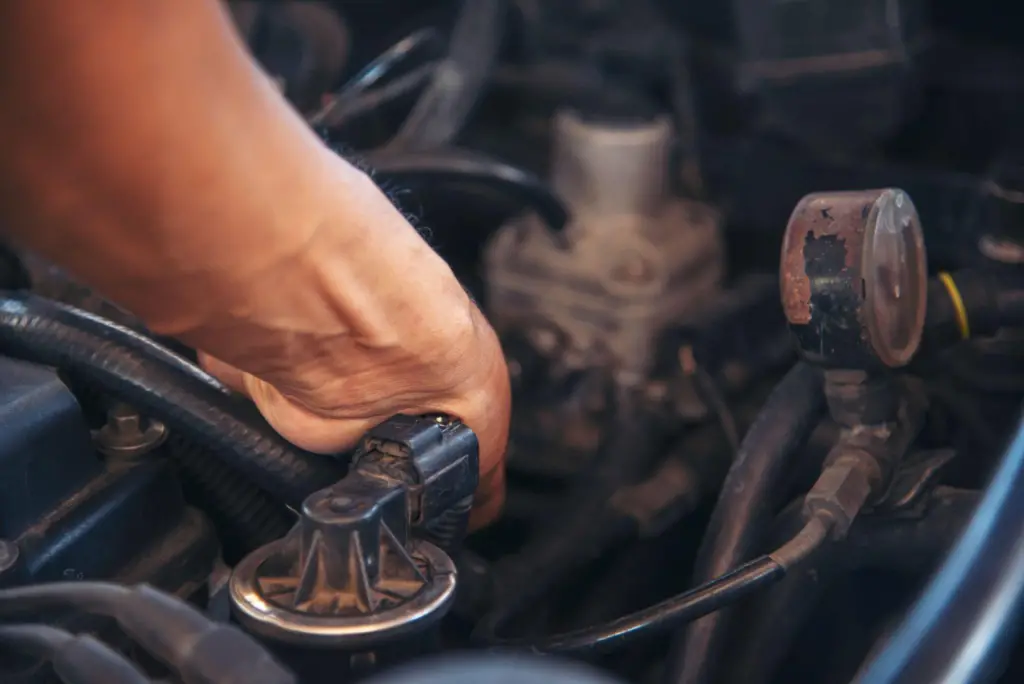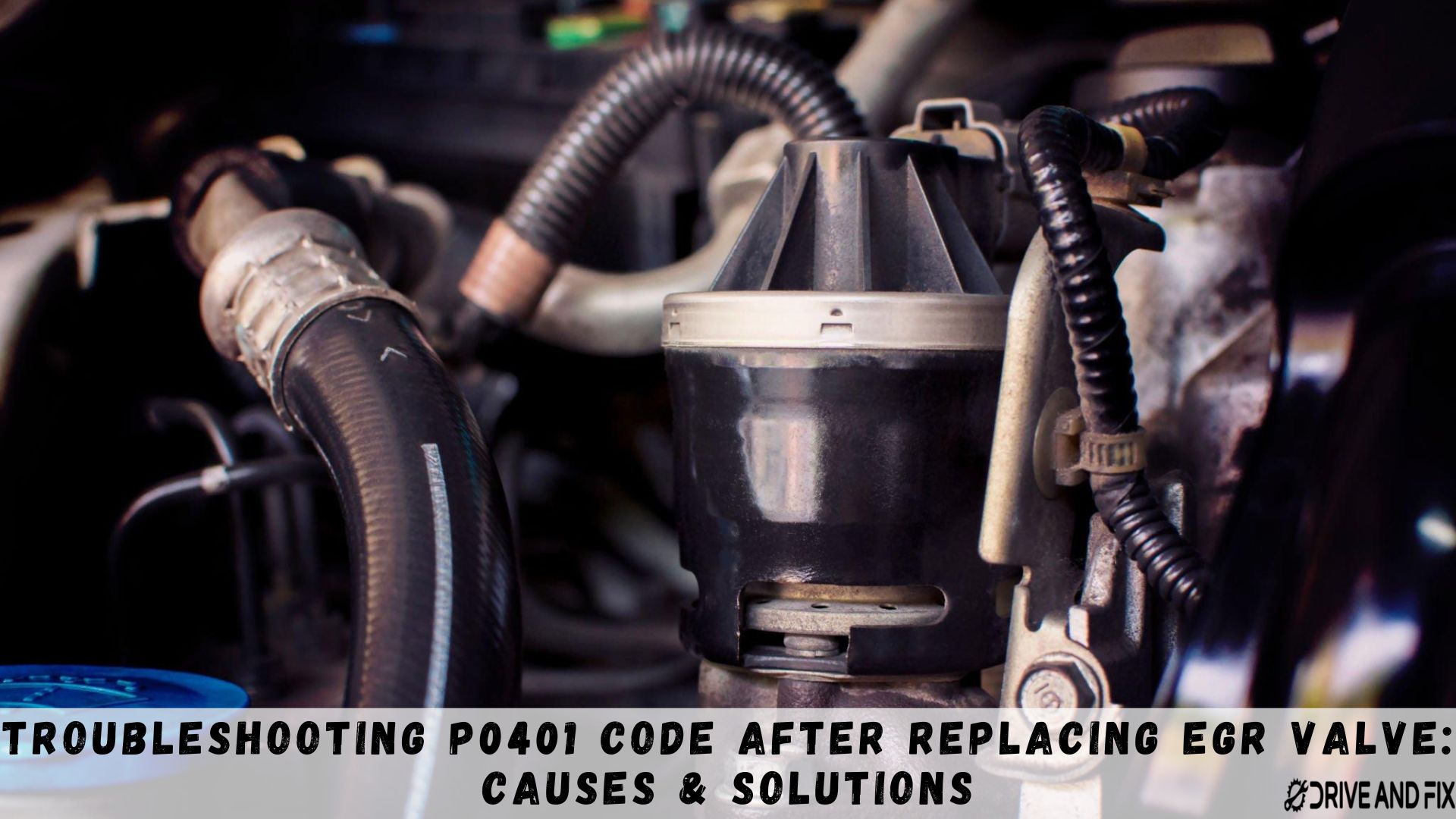If you recently replaced the EGR (Exhaust Gas Recirculation) valve in your vehicle and now you’re encountering the P0401 error code, you might be wondering what went wrong. If you have faced troubleshooting P0401 code after replacing EGR valve, then here we will guide you through understanding the P0401 code, its causes, and the correct process of replacing the EGR valve to ensure optimal performance of your vehicle.
Understanding the P0401 Code
The P0401 code is a generic OBD-II error code that indicates an issue with the EGR system. When this code appears, it means that the EGR system is not functioning properly, leading to increased emission levels and potential performance issues in your vehicle. By diagnosing and resolving the P0401 code promptly, you can maintain the efficiency and longevity of your engine.
What is the most common cause of a P0401 EGR code After EGR Valve Replacement?

The most common cause of a P0401 EGR code appearing after EGR valve replacement is a clogged EGR passage. When the EGR passage becomes blocked or restricted by carbon deposits, it hinders the proper flow of exhaust gases. Even after replacing the EGR valve, if the passage is not thoroughly cleaned, the P0401 code may persist. Therefore, it is crucial to ensure that the EGR passage is clean and free from any obstructions during the EGR valve replacement process.
How Do I Fix Code P0401: Step-by-Step Guide
To fix the P0401 code, follow this step-by-step guide:
Gather necessary tools: Collect the tools and equipment you’ll need, including a socket wrench set, pliers, a new EGR valve, a gasket, and a cleaning solution for the EGR passage.
Locate the EGR valve: Consult your vehicle’s service manual or online resources to find the EGR valve’s location. Typically, it is situated near the intake manifold or cylinder head.
Disconnect the negative battery cable: Prioritize safety by disconnecting the negative battery cable. This precaution prevents any electrical mishaps while working on the EGR system.
Inspect the EGR valve and passage: Check the condition of the EGR valve and examine the EGR passage for carbon buildup or obstructions. If the passage is clogged, it will require cleaning.
Remove the EGR valve: Using the appropriate tools, carefully remove the bolts or clamps securing the EGR valve to the engine. Also, disconnect any electrical connectors or vacuum hoses connected to the valve.
Clean the EGR passage: Thoroughly clean the EGR passage using a suitable cleaning solution. Remove any carbon deposits or debris that might be obstructing the passage. Ensure a clear and smooth flow for exhaust gases.
Install the new EGR valve: Position the new EGR valve in place, aligning it properly. Use a new gasket to create a tight seal. Reconnect any electrical connectors or vacuum hoses that were previously disconnected.
Reconnect the negative battery cable: Once the new EGR valve is installed, reattach the negative battery cable to restore power to the vehicle.
Clear the error code: Use an OBD-II scanner to clear the error code associated with the P0401. Alternatively, you can disconnect the battery for a few minutes to reset the system.
Test drive and monitor: Take your vehicle for a test drive to ensure that the P0401 code does not reappear. Monitor the system for any signs of the code returning or any other issues.
If the P0401 code persists after following these steps, it is advisable to consult a professional mechanic for further diagnosis and potential repairs.
What to Do After Replacing the EGR Valve

After replacing the EGR (Exhaust Gas Recirculation) valve, it is important to take a few additional steps to ensure proper functionality and prevent any potential issues. Here’s what to do after replacing the EGR valve:
Clear the error codes: Use an OBD-II scanner to clear any error codes that may have been triggered by the previous faulty EGR valve. This step ensures that the vehicle’s onboard computer recognizes the new EGR valve and starts fresh.
Inspect the EGR passage: Before starting the engine, inspect the EGR passage to ensure it is clean and free of any debris or carbon buildup. If necessary, clean the passage thoroughly using an appropriate cleaning solution.
Double-check connections: Verify that all electrical connectors and vacuum hoses associated with the EGR valve are securely connected. Loose or improperly connected components can lead to performance issues or trigger error codes.
Reconnect the negative battery cable: Reconnect the negative battery cable that was disconnected earlier for safety purposes. This step restores power to the vehicle and allows the EGR valve to operate as intended.
Test the EGR system: Start the engine and let it idle for a few minutes. Monitor the vehicle’s performance and observe for any abnormal behavior, such as rough idling or excessive exhaust emissions. If everything appears normal, proceed to the next step.
Take a test drive: Take the vehicle for a test drive, paying attention to the engine’s responsiveness and overall performance. Ensure that there are no warning lights or error codes reappearing during the drive.
Monitor for recurring issues: After the test drive, continue monitoring the vehicle for any recurring issues, such as the P0401 code or related symptoms. If the code reappears or any problems persist, it is recommended to consult a professional mechanic for further diagnosis and potential repairs.
By following these steps, you can ensure that the newly replaced EGR valve is functioning properly and that the vehicle’s EGR system is operating efficiently, leading to improved performance and reduced emissions.
How do you test a new EGR valve
To test a new EGR (Exhaust Gas Recirculation) valve, follow these steps:
Visual inspection: Begin by visually inspecting the EGR valve for any visible defects or damage. Ensure that all connections, hoses, and electrical connectors are properly attached and secure.
Check resistance: With the engine off, use a multimeter to measure the resistance of the EGR valve’s solenoid coil. Consult the vehicle’s service manual or manufacturer’s specifications for the correct resistance range. If the resistance is significantly outside the specified range, it may indicate a faulty valve.
Perform vacuum test: Start the engine and let it idle. Locate the vacuum hose connected to the EGR valve. Carefully disconnect the hose from the valve and connect a hand-held vacuum pump in its place. Apply a vacuum to the valve and observe its response. The valve should open smoothly and remain open as long as a vacuum is applied. If the valve fails to open, it may indicate a defective valve.
Monitor engine performance: While the engine is running, monitor its performance closely. Observe for any irregularities such as rough idling, hesitation, or excessive emissions. A properly functioning EGR valve should help improve engine performance and reduce emissions.
Scan for error codes: Use an OBD-II scanner to scan for any error codes related to the EGR system. If the scanner detects any relevant error codes, it may indicate a problem with the EGR valve or the EGR system as a whole.
Test drive: Take the vehicle for a test drive and pay attention to its overall performance. Note any changes in engine responsiveness, fuel efficiency, or exhaust emissions. If the vehicle exhibits improved performance and there are no abnormal symptoms, it suggests that the new EGR valve is functioning correctly.
It’s important to consult the specific guidelines provided by the vehicle manufacturer or refer to the service manual for precise testing procedures and specifications. If you encounter any issues or suspect a faulty EGR valve, it is recommended to seek assistance from a qualified mechanic for further diagnosis and potential repairs.
Is it safe to drive with the P0401 code?

Driving with the P0401 code is generally considered safe, but it is not recommended to ignore or neglect the issue for an extended period. The P0401 code indicates a problem with the EGR (Exhaust Gas Recirculation) system, specifically the insufficient flow of exhaust gases detected by the vehicle’s onboard diagnostics.
Here are a few points to consider:
Reduced fuel efficiency: The P0401 code can affect the fuel efficiency of your vehicle. Since the EGR system helps in reducing emissions and improving fuel economy, a malfunctioning EGR valve can lead to decreased gas mileage.
Elevated emissions: The purpose of the EGR system is to recirculate a portion of exhaust gases back into the combustion chamber. This process helps lower the formation of harmful nitrogen oxide (NOx) emissions. If the EGR system is not functioning properly, it can result in increased emissions, potentially contributing to air pollution.
Engine performance: While the P0401 code itself may not directly affect the drivability of the vehicle, a malfunctioning EGR valve can lead to rough idling, hesitation, or a lack of power during acceleration. Over time, these symptoms can worsen if the underlying issue is not addressed.
Risk of further damage: Ignoring the P0401 code for an extended period can potentially lead to additional damage to the EGR system or related components. It’s advisable to address the issue promptly to prevent further complications and costly repairs.
Therefore, although driving with the P0401 code is generally safe, it is important to have the issue diagnosed and repaired as soon as possible. Consult with a qualified mechanic who can inspect the EGR system, identify the root cause of the problem, and perform the necessary repairs or replacements. This will help ensure optimal vehicle performance, fuel efficiency, and compliance with emission standards.
Tips and Tricks
Certainly! Here are five tips and tricks related to the P0401 code and EGR system:
Regular maintenance: Implement regular maintenance practices for your vehicle, including periodic inspection and cleaning of the EGR system. This helps prevent carbon buildup and ensures the smooth operation of the EGR valve, reducing the chances of encountering the P0401 code.
Use quality fuel: Opt for high-quality fuel from reputable sources. Quality fuel with proper additives can help minimize carbon deposits and keep the EGR system clean. This promotes better performance and reduces the likelihood of EGR-related issues.
Avoid short trips: Whenever possible, try to avoid frequent short trips with your vehicle. Extended highway driving allows the engine to reach optimal operating temperatures, which helps burn off carbon deposits in the EGR system. Regularly taking longer drives can help prevent carbon buildup and maintain the EGR system’s efficiency.
Clean the EGR passage: Periodically clean the EGR passage, even if there are no apparent issues. This preventive measure ensures that the passage remains clear and allows for the proper flow of exhaust gases. Cleaning can be done using specialized EGR cleaning solutions and following the manufacturer’s instructions.
Address other engine issues promptly: Address any other engine issues or warning signs promptly. Engine problems such as misfires, vacuum leaks, or fuel system malfunctions can indirectly impact the EGR system’s performance. Timely repairs and maintenance help maintain the overall health of the vehicle and reduce the chances of encountering EGR-related problems.
Remember, while these tips and tricks can help minimize the chances of experiencing the P0401 code, it’s always recommended to consult with a professional mechanic for accurate diagnosis and appropriate solutions if the code persists or if you encounter any other vehicle-related issues.
Frequently Asked Questions (FAQs)

Will the P0401 code clear itself?
The P0401 code will not clear itself automatically. Once the check engine light is triggered and the P0401 code is stored in the vehicle’s onboard computer, it will remain until the issue is addressed and the code is cleared using an OBD-II scanner or by fixing the underlying problem.
Can a faulty EGR valve cause the P0401 code?
Yes, a faulty EGR valve can cause the P0401 code to appear. If the EGR valve is not functioning properly, it can lead to an insufficient flow of exhaust gases, triggering the P0401 code. A clogged or stuck EGR valve, as well as issues with the EGR solenoid or related components, can contribute to the code being set.
How often should I clean the EGR valve to prevent P0401 code issues?
The frequency of EGR valve cleaning depends on various factors such as the vehicle’s make and model, driving conditions, and maintenance history. In general, it is recommended to clean the EGR valve and the associated passage at regular intervals as part of routine maintenance. Consult your vehicle’s service manual or a qualified mechanic for specific recommendations based on your vehicle.
Is it possible to bypass the EGR system to avoid the P0401 code?
While it may be technically possible to bypass the EGR system, it is not recommended or advisable. The EGR system plays a crucial role in reducing emissions and improving fuel efficiency. Bypassing the system can lead to increased emissions, poor engine performance, and potential issues with the vehicle’s overall operation. It’s best to address and resolve the underlying problem causing the P0401 code rather than attempting to bypass the system.
Are there any temporary fixes for the P0401 code?
Temporary fixes for the P0401 code are not recommended as they may not address the root cause of the issue. It’s important to diagnose and fix the underlying problem causing the code to ensure the proper functioning of the EGR system and overall vehicle performance. Temporary solutions may not provide a long-term resolution and can potentially lead to further complications.
Conclusion
Encountering the P0401 code after replacing the EGR valve can be frustrating, but it’s not uncommon. The code indicates a potential issue with the EGR system, such as insufficient flow of exhaust gases. While the replacement of the EGR valve itself may have resolved the original problem, there are additional steps to take to ensure proper functionality. Clearing error codes, inspecting the EGR passage, double-checking connections, and performing thorough testing are essential after EGR valve replacement. Regular maintenance, prompt addressing of engine issues, and following recommended cleaning intervals can help prevent the recurrence of the P0401 code. If the code persists or other symptoms arise, professional assistance is recommended for further diagnosis and necessary repairs. By taking the appropriate steps, you can ensure the EGR system operates optimally and maintain a smooth and reliable vehicle performance.


